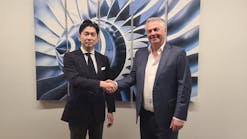Overair Receives $145 million Investment from Hanwha Group to Develop All-Electric VTOL Aircraft
Electric vertical takeoff and landing vehicle (eVTOL) company, Overair, announced its most recent funding of $145 million from Hanwha Systems and Hanwha Aerospace, global leaders in ultra-precision communications and aircraft technologies. With this new investment, Overair remains on track to fly its all-electric experimental prototype in the second half of 2023.
Hanwha's continued investment in Overair not only fuels the ongoing development of Butterfly but will also allow Overair to lay the groundwork for commercializing their mobility technology. In addition to their investment, Hanwha will also provide electric motors and battery packs for Overair's prototypes, as the two companies expand their R&D co-operation.
"This is a tremendous milestone for our growing team, and we're extremely well positioned to deliver sustainable aerial ridesharing to the world through the development of Butterfly," said Ben Tigner, Co-Founder and CEO of Overair. "We're exactly where we want to be, building a superior aircraft company with class leading mobility technology around an unrivaled aircraft while rapidly approaching the first flight of a purpose-built prototype next year. We've proven Butterfly's propulsion system, so we'll now begin validating Butterfly's ability to operate safely in real-world weather conditions, carry significant payloads, and fly incredibly quietly."
Butterfly is an all-electric aircraft with six seats designed to take off and land vertically. The aircraft's advanced propulsion system is derived from decades of military VTOL programs led by Abe Karem. Thanks to this legacy of proprietary engineering, Butterfly's propulsion is extremely efficient and will give Butterfly the broadest flight envelope and smallest sound footprint of any aircraft in the burgeoning industry. Specifically, Butterfly's unique Optimum Speed Propulsion (OSP) uses four large propellers, which spin slowly when hovering and even slower when cruising, and draw only a fraction of the available motor power, giving Butterfly extra payload capacity and power margins to operate safely in challenging environmental conditions. Additionally, the slow-turning props produce extraordinarily little sound, which will allow Butterfly to operate in high-density areas with noise sensitive communities.
"Hanwha's basic principles for new business development is to focus on 'Disruptive Innovation' that can uproot and shift the market and technology trends based on its core capabilities. In alignment with its core capabilities as well as its main businesses, Hanwha is selecting 'Game Changer' businesses that it can really excel in the future, and eVTOL vehicle is one of the 'Game changer,'" said Mr. Sungchul Eoh, CEO of Hanwha Systems. "With regard to our investment decision in Overair, we assessed that the company had the numerous patients and core technologies required to develop highly efficient, low noise vehicle. Therefore, we expected that Overair would be capable of developing superb vehicle that can satisfy the requirements for safety, efficiency, speed, low noise, and environment-friendly feature. We see the potential of Overair's Optimum Speed Propulsion system and we will continue to work together to find synergies and bring this breakthrough technology to the world."
As the company continues to work toward FAA certification, Overair is also working with NASA and Urban Movement Labs in Los Angeles to develop urban air mobility (UAM) routing and infrastructure.



